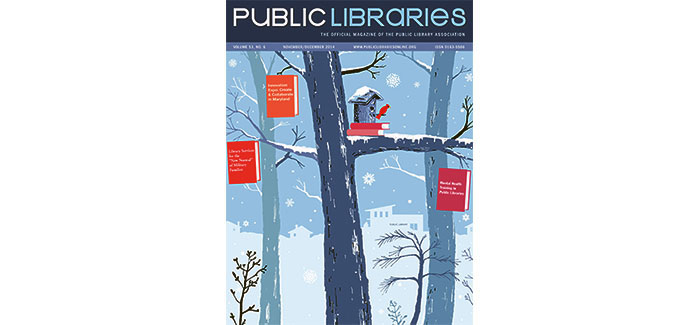Re-Envisioning Public Libraries

Although I have to admit feeling a bit self-conscious about wearing Mickey Mouse ears with a tassel after recently “graduating” from a workshop at the Disney Institute (DI), the training from that day was nothing to laugh about and really got me thinking about the Aspen Institute’s (AI) “Rising to the Challenge: Re-Envisioning Public Libraries” report released in October.1 Disney’s workshop was targeted to a broad range of attendees from the private and public sectors with a focus on leadership, creativity, and innovation. AI’s report is focused on public libraries and offers a call to action for library leaders, policy makers, and the community. The following are some of the interesting parallels I observed between the two institutes.
DI: “Don’t be afraid to cannibalize your own business in the name of progress. Innovation is as much about what you discontinue as what you continue or create.”2 Remaining relevant has been on libraries’ radars for the past twenty years with the rise of the Internet and then e-books. While libraries have done a great job at adopting and integrating these into their core service offerings, the notion that anything is sacred or forever is a tough one to move beyond. Will the physical book someday end up on our “stop doing” list? DI used the example of Kodak, whose core business was selling film for cameras. Rather than leveraging their lead in the development of digital cameras, Kodak clung to film and the rest is unfortunate history. AI suggests that library leaders, “Define the scope of the library’s programs, services and offerings around community priorities, recognizing that this process may lead to choices and trade-offs.” and simply to, “Deploy existing resources in new ways.”
Although Walt Disney has been gone for nearly fifty years, the company that still bears his name today continues to be a remarkable success story. Yet, even as iconic as the company has become and the traditions it has sparked in generations of visitors, from a business perspective it must continue to reinvent itself.
DI: “You can’t allow tradition to get in the way of innovation. There’s a need to respect the past, but it’s a mistake to revere your past.”3 We are in an experience economy where it is imperative to orchestrate memorable events for consumers of products and services. We are moving from transactional experiences to transformational experiences. AI recommends, “Change long-held rules and operating procedures that impede the development of the library’s spaces and platform.” How are we transforming the lives of our users and when was the last time we made a library policy shorter rather than longer?
Of course few corporations are better at marketing and telling a story than Disney. As noted in the DI workshop, “Research suggests that it is much easier to remember stories than it is to remember facts.” For far too long the library community has relied on telling its story of success through transactional data, circulation, door counts, computer sessions, and questions asked. Thanks to the leadership of immediate PLA Past President Carolyn Anthony, the Performance Measurements Task Force is working diligently to prepare tools for libraries to better measure impact and outcomes (more to come on this in 2015). AI calls library leaders to, “Measure library outcomes and impacts to better demonstrate the library’s value to the community and communicate these outcomes to key partners and policy makers,” and to “Communicate the library’s story of impact directly to the public, partners, stakeholders and policy makers. Include the new vision built on the library’s people, place and platform assets.” Needless to say we have a lot to learn about collecting stories, measuring impact, and then using them to influence decision-makers about support of the library—whether voters, elected officials or municipal administrators.
DI: “To be successful in a changing economy—to ensure that people can perceive the world in new ways, recognize patterns, make connections between seemingly unrelated details, ask probing questions, and generate new ideas—organizations must combat the tendency towards left-brain dominance and foster whole-brain thinking.” This statement reminded me of how library-centric our worlds are. It is remarkably easy to forget the broader community around us that we serve. We think that because we post a sign in the library or send a newsletter to every home about a service that these will become top of mind to the members of our community. Likewise, many often limit thinking within the library bubble we live in rather than the community as a whole. AI advises, “Engage the community in planning and decision making, and seek a seat at tables, where important policy issues are discussed and
decisions made.” I would further challenge everyone to take it a step further as someone recently wisely advised me, “Don’t just seek a place at the table, set it so that you don’t end up on the menu.”
I encourage everyone to read the AI report and call to action. You may also consider signing up for the DI blog.4 As Walt Disney once said, “Whatever we accomplish belongs to our entire group, a tribute to our combined efforts.” I am confident that together we will rise to the challenge
of re-envisioning public libraries.
References
- Amy K. Garmer, Rising to the Challenge: Re-Envisioning Public Libraries, a report of the Aspen Institute Dialogue on Public Libraries, Oct. 2014, accessed Dec. 4, 2014.
- Pete Pachal, “How Kodak Squandered Every Single Digital Opportunity It Had,” Mashable, Jan. 20, 2012, accessed Dec. 4, 2014.
- Bob Iger, Chairman and CEO of the Walt Disney Company.
- Talking Point: The Disney Institute Blog.
Tags: Aspen Institute, library outcomes










